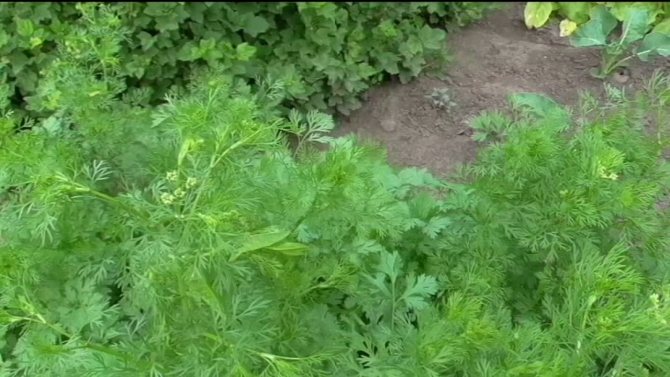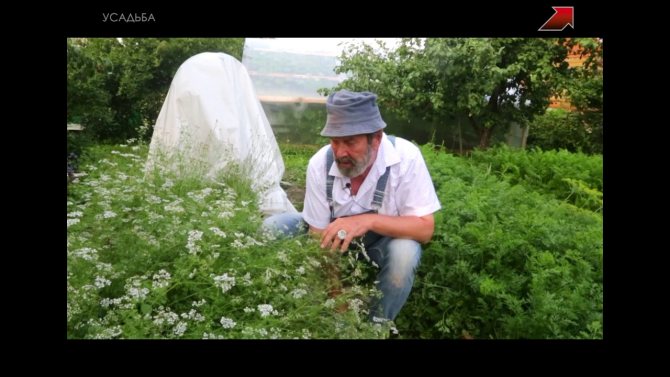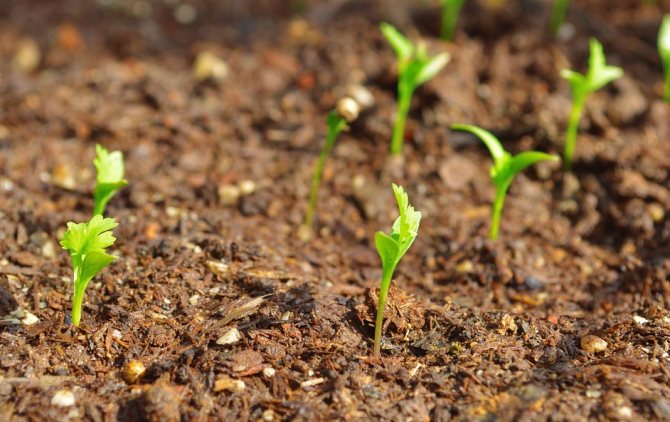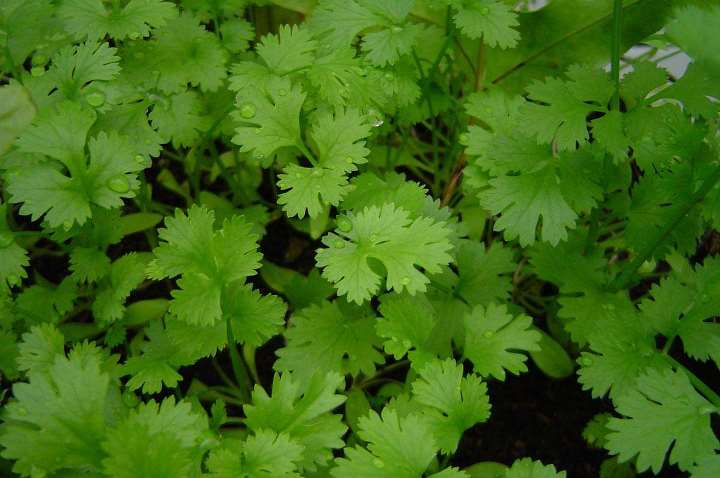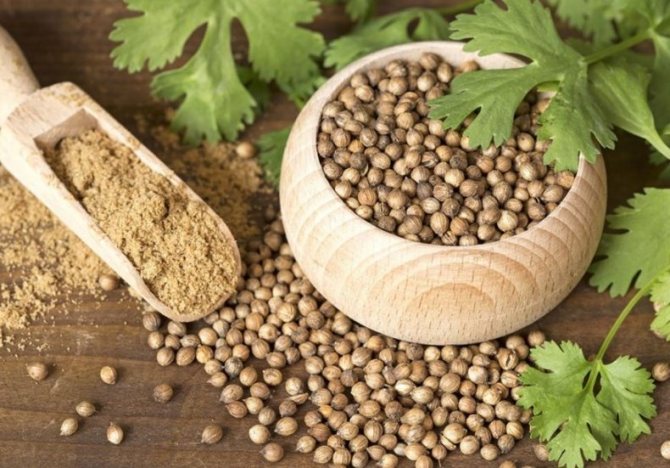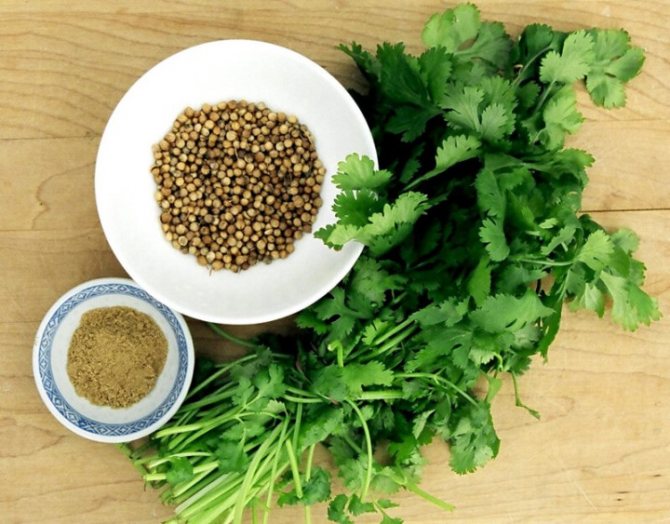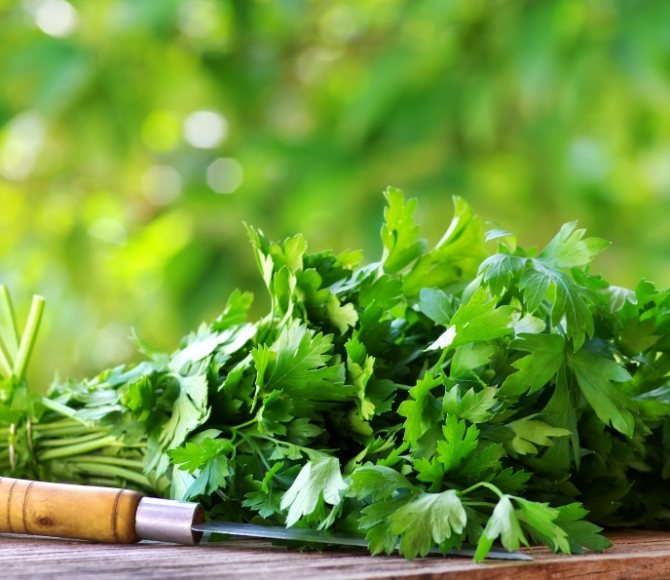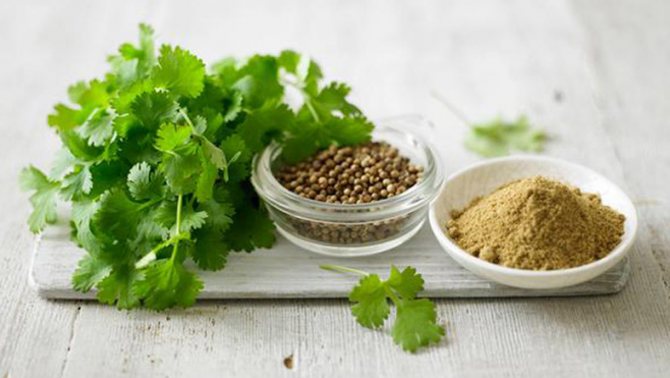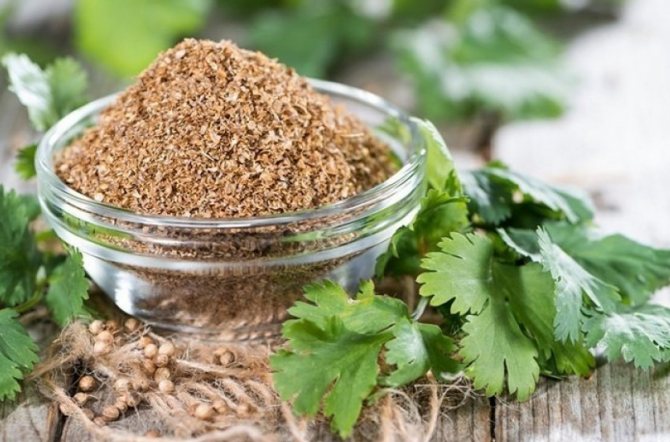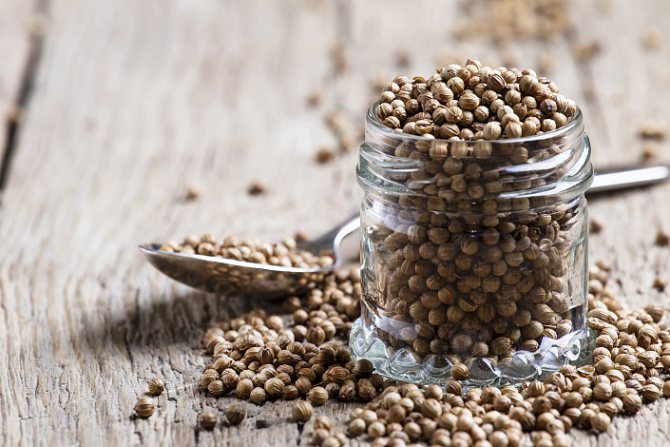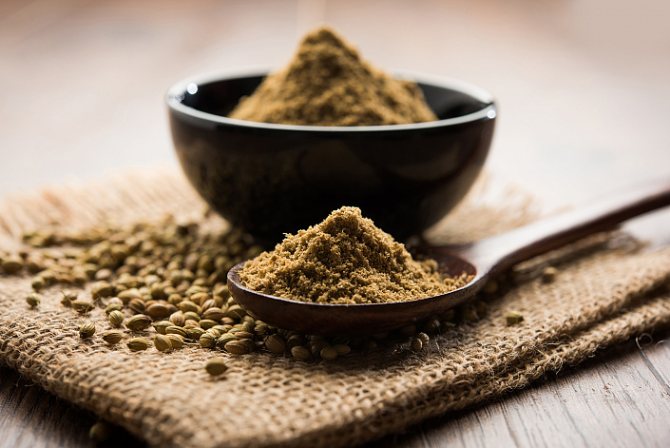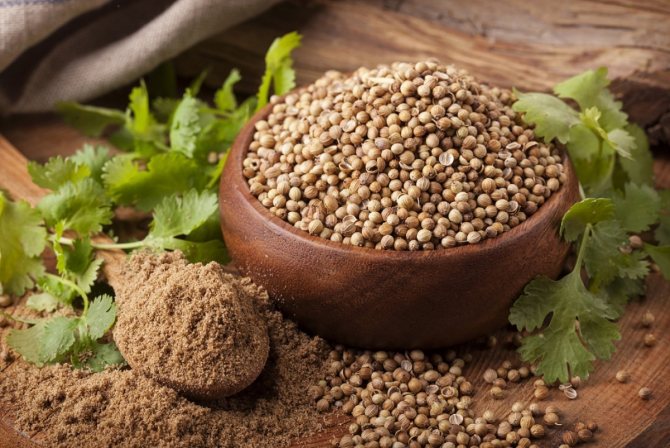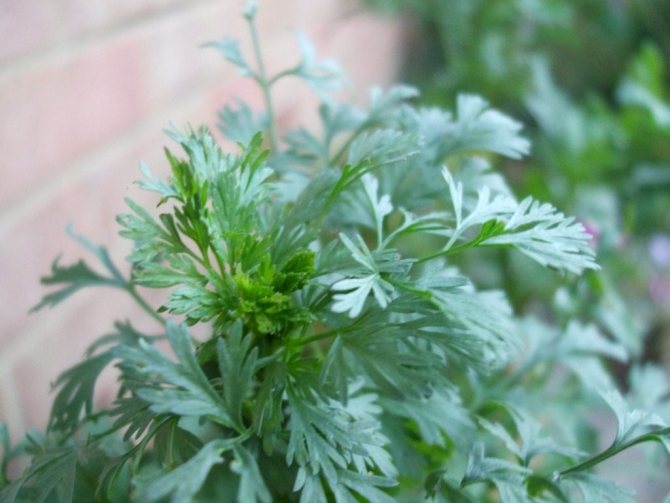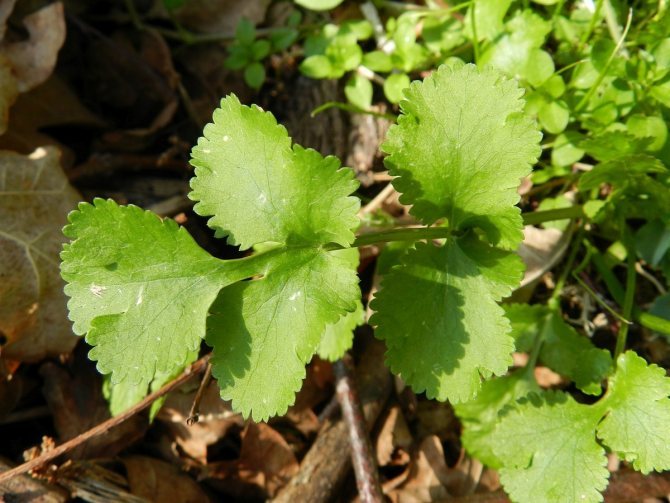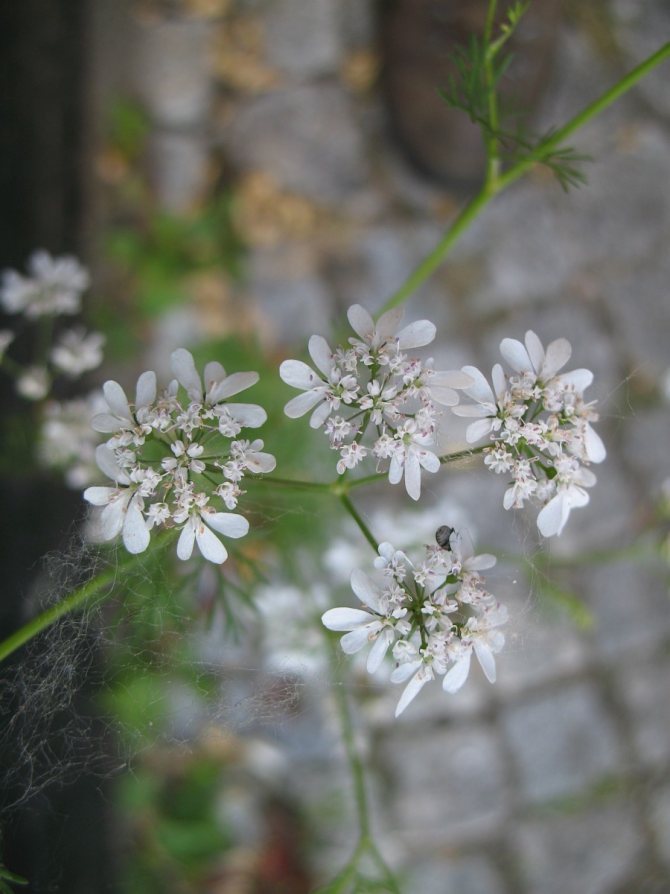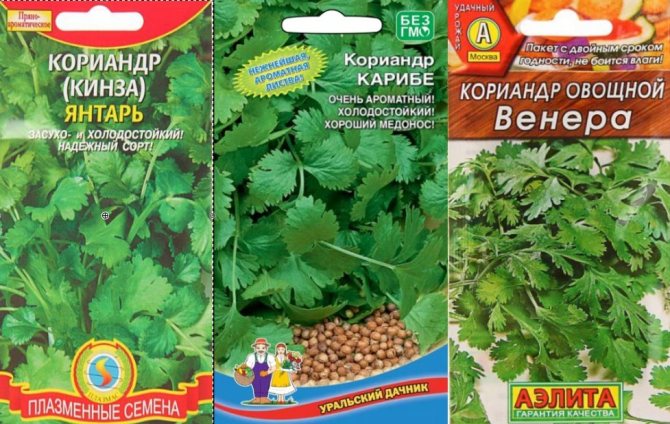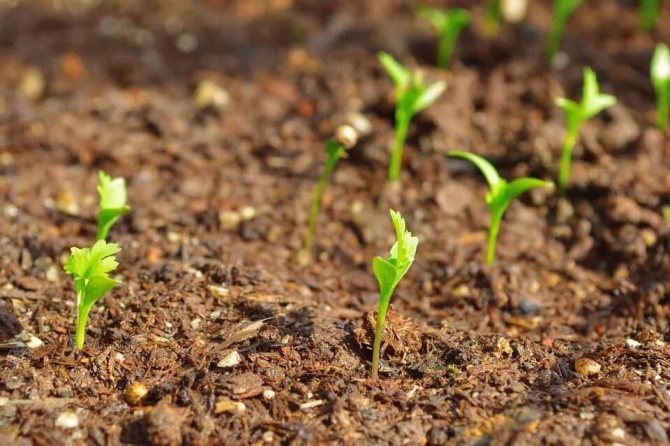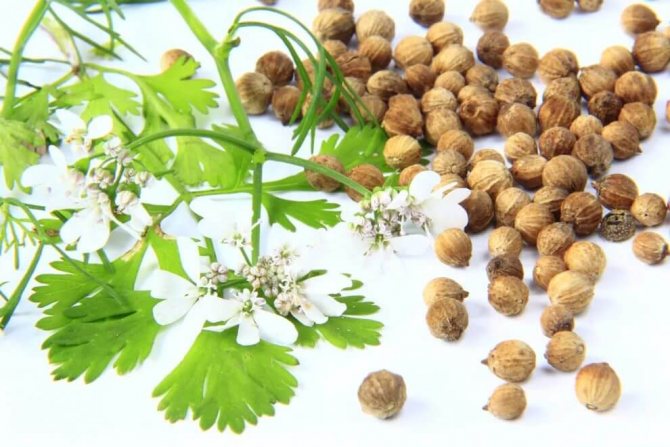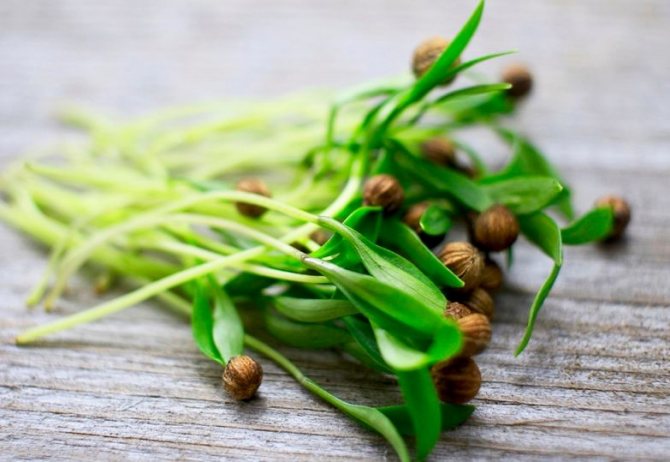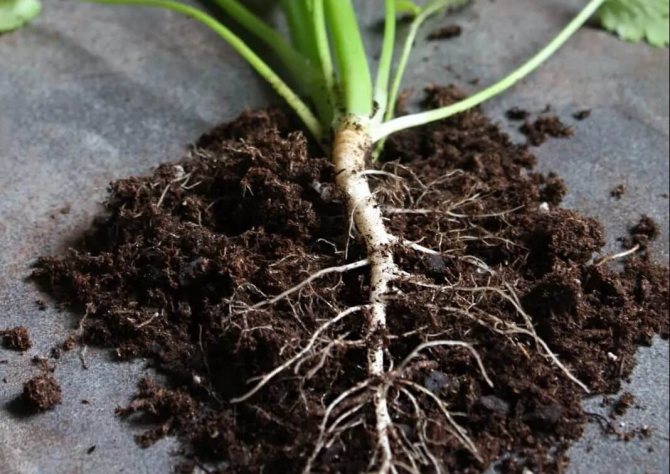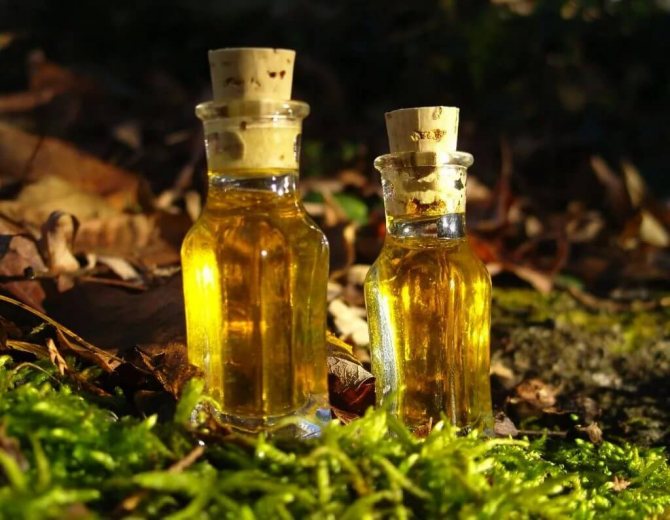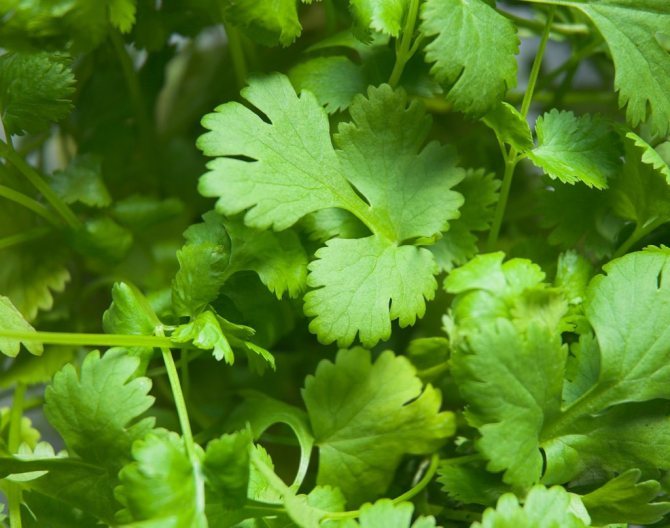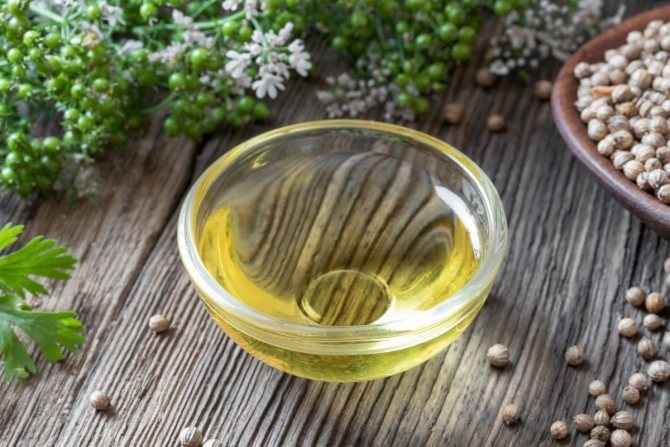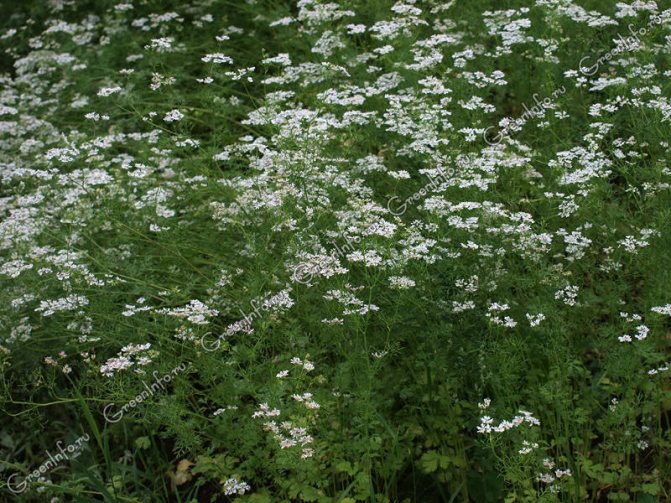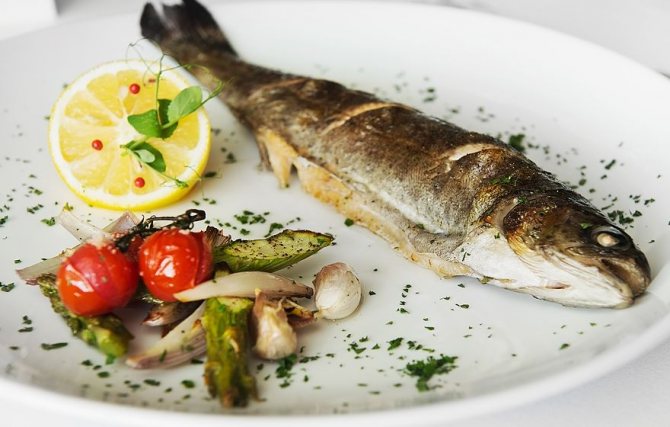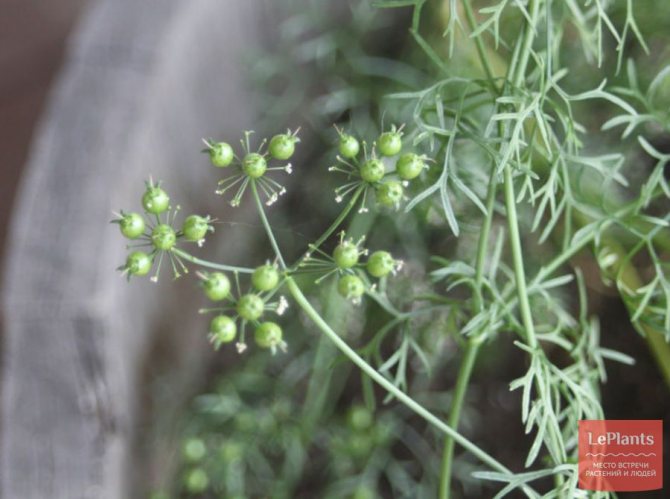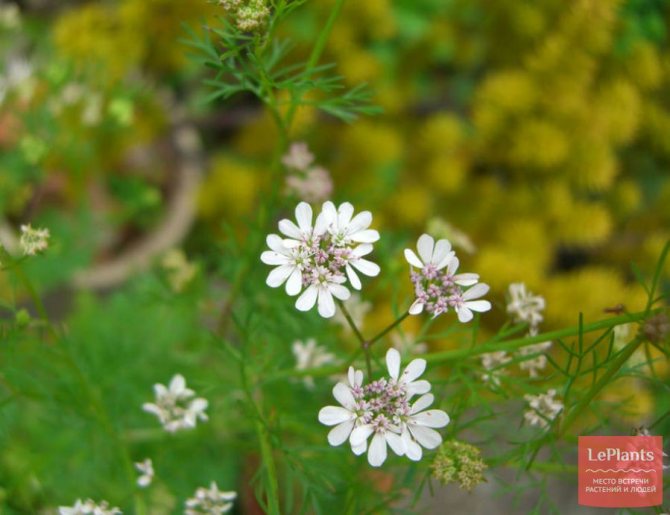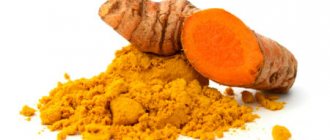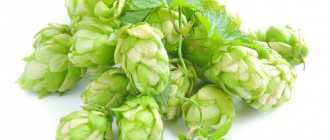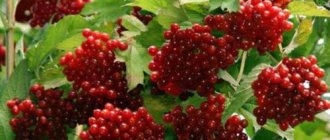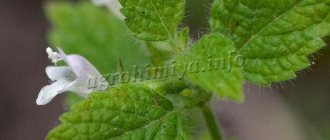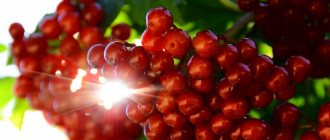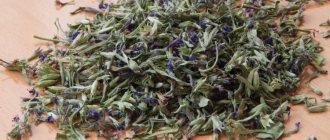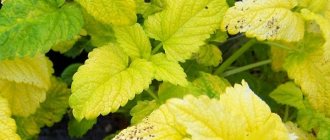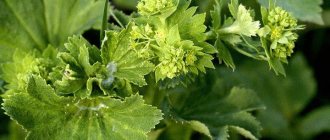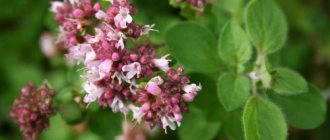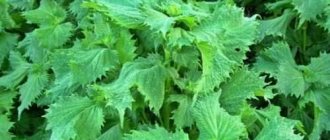Sowing coriander (Latin Coriandrum sativum) is one of the most ancient spicy plants in the world. Another scientific name is vegetable coriander. It is popularly known as cilantro. People in India, China and Egypt have been consuming it for thousands of years and using it to treat various diseases. The healing power of the plant is reported in the Old Testament and in Sanskrit texts. The supposed homeland of Coriandrum sativum is the Mediterranean. Initially, he most likely grew up in Algeria, Sinai, Israel, Lebanon, Jordan, Bulgaria, Croatia, Slovenia. Now it is grown in South and North America, Europe, Asia.
What is this plant
Coriander is a herbaceous annual, belongs to family Umbrella. The name comes from the ancient Greek language, where a similar sounding word meant "bug". This is due to the specific smell of an immature plant, which is given to it by the decyl aldehyde contained in the essential oil. However, by the end of ripening, it disappears almost completely.
Meet other names: kishnets, Chinese parsley, kolyandra, klopovnik, hamem, kashnich. Latin designation - Coriandrum sativum, translated into english - Coriander, cilantro.
How and where it grows
The eastern Mediterranean is considered the birthplace of coriander. Wild species are widespread in India, China, South America, southern European Russia, and the Caucasus. The healthy spice is cultivated everywhere.
The plant is sun-loving, drought-resistant, prefers slightly acidic sandy loam or loamy soil. It does not take root well on heavy, clayey soil. Requires regular moderate watering, weeding, loosening. The recommended minimum distance between bushes is 10 cm, between rows - 25 cm.
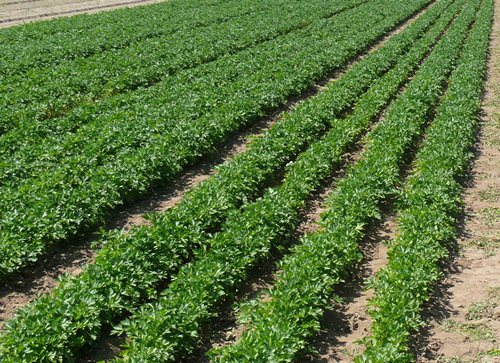
Plantation
The greens are suitable for food before flowering (June-July), young shoots 10-15 cm are especially tasty. The seeds are harvested after full maturity in August-September. To fresh cilantro was on the table all summer, it is worth re-sowing it at intervals of 2-3 weeks.
Which agrobiological group does
Coriander is classified as green vegetable crops. Due to its cold hardiness and early maturity, it is grown from early spring, gives several harvests per season. Fertile soil, timely moistening with thinning - a guarantee that the leaf will be coarse, juicy, spicy.
What does it look like
The plant reaches 70 cm in height. The root is 30-40 cm, fusiform, the stem is erect, glabrous, branched. Leaves of pronounced green colors, differ depending on the location:
- basal - long-petiolate, broad-lobed, with incised serrated edges;
- lower stem - short petiolate, pinnately divided;
- the upper ones are sessile, pinnately dissected.
Inflorescences are umbellate, with white or pink small flowers. Fruits are light brown, spherical, ribbed.
Cilantro is often confused with parsley. Outwardly, they can be distinguished by the edges of the sheet plate: in the first they are rounded, in the second they are more pointed.
- vitamins A (retinol), B1, B2, B4, C, E, PP;
- trace elements (iodine, iron);
- macronutrients (potassium, calcium, magnesium, sodium, phosphorus);
- flavonoids (plant polyphenols);
- digestible carbohydrates (dextrins, starch, mono-, disaccharides);
- tannins;
- fiber;
- essential oil.
According to article pharmacopoeias the content of heavy metals meets safety requirements.
Interesting: there are no fats in the seeds of kolyandra.
Varieties
Among the dozens of types of seed coriander, the following are the most popular:
- "Debut" (mid-season, recommended for open ground, high vitamin E content);
- "Yantar" (leafy, with increased essential oil content);
- "Vanguard" (mid-season, undersized, high
- aromatic, suitable for growing on a windowsill);
- "Taiga" (late ripening, rich color, characterized by increased foliage, strong smell);
- "Picnic" (early maturing, medium-sized (40 cm), high-yielding, suitable for home cultivation).
Important: it is impossible to sow a plant in a lowland, there is a possibility of a delay in ripening, as well as death from waterlogging.
Cilantro and coriander are one and the same
Both names designate different parts of the same plant. Brown seeds are called coriander, and deciduous mass is called coriander. The Russian language borrowed the second word from Georgian, in colloquial speech one can hear the variant "kinza".
Interesting: description Coriandrum sativum is found in the oldest Vedic text, the Atharva Veda.
Growing at home
Get a flower pot or other suitable container that is at least 45 cm wide and 20 to 25 cm deep. The coriander does not like being transplanted, so it must be large enough to accommodate a full-grown plant.
Landing
Fill the pot with soil. Add fertilizer if desired. Sprinkle water on the ground to keep it moist, but not wet. Scatter the seeds so that they are evenly distributed. Cover with soil with a layer of 0.6 cm.
Grass needs a lot of sun to grow, so place the pot on a sunny windowsill or greenhouse. The seeds should germinate within 7-10 days.
Care
Maintain soil moisture by spraying water from a spray bottle. If you pour the water directly onto the ground, the seeds will move.
When the stems are 10-15 cm tall, start harvesting. Cut off up to 75% of the leaves each week, as this promotes cilantro growth. With proper care, up to four crops are harvested from one pot.
Useful properties and contraindications
As a medicine, the plant was used three millennia ago. Common cases where use should be abandoned include:
- gastritis, accompanied by high acidity;
- the recovery period after myocardial infarction;
- ischemic heart disease;
- renal failure;
- diabetes;
- individual intolerance.
Important: the daily dose should not exceed 4 grams cilantro seed or 35 grams of grass. Overdose provokes an allergic reaction, overexcitation, sleep disturbance.
Seeds (fruits)
- effective for a number of diseases of the teeth, oral cavity: chewing grains helps with stomatitis, caries, fights pathogenic bacteria;
- the contained bitterness promotes the production of enzymes, bile, gastric secretion;
- reduces nervousness, resists stress, depression, normalizes sleep;
- lowers cholesterol levels;
- removes toxic substances;
- increases hemoglobin.
Benefit and harm
There are nuances of the effect of the plant on the female and male. organism.
For women
The herb will help with painful periods, relieve pain, relieve muscle spasms. The main thing is not to overdo it: the result of excessive use can be a violation of the menstrual cycle.
During menopause, cilantro drowns out climacteric hot flashes, smooths out mood swings, and prevents depression from blooming.
When breastfeeding it is worth carefully introducing coriander into the diet, it can give milk a bitter taste, cause skin rashes in the baby.
Is it possible there is a kolyandra during pregnancy? A moderate amount will not cause negative consequences, on the contrary, it will relieve heartburn, normalize digestion, and will not allow excess water to linger.
For men
By a combination of factors, with moderate use, cilantro has a positive effect on erection and potency. So the plant increases blood flow to the pelvic organs, prevents prostatitis, has an anti-inflammatory effect if the disease has already been diagnosed. Androsterone in the composition is an analogue of testosterone, it reduces the risk of reducing the synthesis of an important male hormone directly responsible for high libido.
Plus, the herb reduces cravings for tobacco and alcohol, stimulates the withdrawal of smoking products.
Healing properties
Having figured out what kind of coriander plant is, consider the medicinal properties of the spice. Plant-based products increase appetite, normalize digestion and have a choleretic effect. They are used to treat diseases of the liver, gallbladder and intestines.
Coriander effectively relieves coughs due to its expectorant action. Plant-based products are used to treat influenza and SARS.
One of the most important properties of coriander is its ability to stop the development of cancer cells. The plant is used for the prevention of cancer.
In addition, coriander has a wound healing effect. Read more about the medicinal properties in the article Why coriander is useful.
For more information on the medicinal properties of coriander, see the following video:
Coriander as a seasoning
Chinese parsley is used to season food in many countries; Indian cuisine is simply unthinkable without it.
What does it look like
Cilantro stems are smooth, straight, branched from above. The leaves are pinnately-divided, dissected into three parts, wavy. Seeds spherical, oblong in some varieties, with even, sometimes winding ribs.
When properly dried, the greens remain distinctly green, and the fruit color ranges from sandy to pale brown.
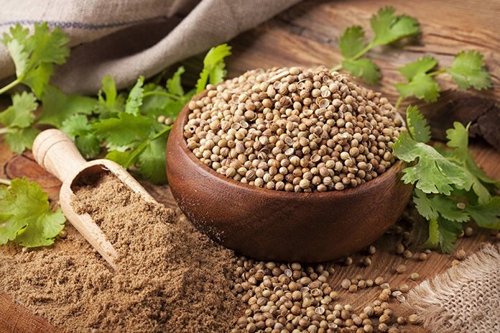

Ground seasoning
What smells
Perception smell cilantro is purely individual. One it smells like bedbugs, another cognac, the third freshly cut bitter grass. The seeds exude scent bark with hints of orange peel.
The shoots have a spicy, lemon-peppery taste with a balanced combination of light pungency and bitterness. The fruits add a sweetish tint, similar for anise, which is especially appropriate for baking bread.
Calorie content
On the 100g cilantro accounts for only 23 kcal, for a similar number of fruits - 25 kcal. At the same time, greens are 90% water. Therefore, the plant is often a component of diet menus.
What is combined with
A safe use of cilantro is to put it in the same place where you usually put the dill. Also, fresh spice successfully "makes friends" with onions, garlic, watercress, savory, basil, dried grains complement cumin, caraway seeds, turmeric.
What can be replaced
In salads, it is allowed to replace cilantro with parsley, thyme, purple basil. Instead of ground spices for the first and second courses, Provencal herbs, anise, dill seeds, ground ginger, saffron are suitable, depending on recipe.
How to store
There are two ways to keep greens fresh for up to two weeks:
- They do not wash the bunch, examine it, get rid of obvious dirt, spoiled areas, cut the stems. Clean water is poured into the jar, a herbaceous bouquet is placed, they make sure that the liquid does not touch the leaves. Cover with a bag, which is secured with a rubber band. Put in the refrigerator. The water is changed at least every 3 days.
- Unwashed, sorted out cilantro is placed in a bag, a peeled onion is placed there, tied, sent to the refrigerator. The bag is changed when condensation forms, the bulb is changed every 4 days.
Dried spices are stored away from direct light, stove and radiator, in a dry, ventilated place.The container is suitable for glass, ceramic, tin with a sealed lid.
For winter fresh chopped leaves are frozen or salted.
Spring sowing of coriander
If coriander has not been sown before winter, then in April you can start sowing, although due to low night temperatures, germination is slow. If nighttime temperatures exceed +6 ° C, then seed germination occurs within 10 days. High soil moisture contributes to the rapid germination of seeds.
A place for growing coriander during spring or winter sowing is chosen slightly shaded. In direct sunlight, cilantro leaves shrink, become tough and quickly turn yellow.
On a note! The essential oil contained in the fruit greatly inhibits seed germination. Therefore, before sowing, cilantro seeds are kept in warm milk for about four hours (just like the seeds of anise, caraway seeds, parsley). As you know, essential oils dissolve well in fats, and after about four hours, milk acquires a light cilantro aroma. The seeds are washed with warm water and can now be sown.
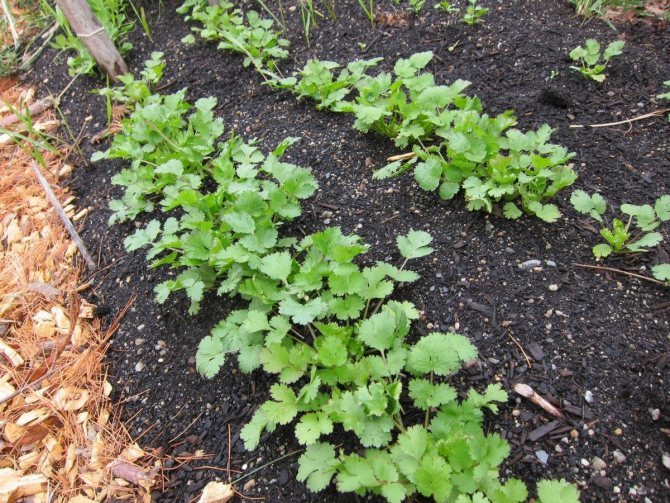

For successful cultivation of coriander, sandy loam and loamy soils with a slightly alkaline reaction and sufficient lighting are suitable.
The distance between the sowing rows is 20 cm, and between the plants in a row - 10 cm.The sowing depth is approximately 1 cm.
The aroma of coriander is strong enough and affects the neighbors in the garden. For example, fennel and dill have decreased taste and aroma. But cilantro cannot “compete” with mint, the aroma of cilantro itself becomes much weaker or disappears altogether.
Since the stem of the coriander is quite flexible, by the time the fruit develops, it is tied to a support.
Water the coriander abundantly, but reduce watering after flowering and stop altogether during the ripening of the seeds.
How coriander is used in cooking
The spice is widely used. It is found in recipes for dishes of different levels: from simple snacks to desserts, cheese making, sausage production.
Where add
Most successful spice manifests itself in:
- legume soups (lentils, chickpeas, beans);
- cabbage stew;
- sauces (tkemali, adjika, satsebeli, mole);
- marinades for fish;
- rye bakery products;
- leafy salads;
- goulash;
- dishes from beets, carrots, pumpkins;
- warming drinks (mulled wine, grog, punch, coffee, hot chocolate).
Coriander is invariably an ingredient in famous spice mixtures: curry, garam masala, suneli hops.
What to cook
Start your acquaintance with simple recipes. Make a simple cilantro and radish salad with lemon juice. Rub the pork with ground spice before baking. Combine chopped herbs with butter and place on top of hot baked potatoes. Add grains to your favorite canning recipes. As you get used to it, the functionality of the spicy supplement will grow.
Coriander coffee: Mix 2 tablespoons of condensed milk, ½ powder spice, a pinch of nutmeg, add to the brewed drink, garnish with heavy cream, sprinkle with cocoa.
Where else is coriander used?
The plant has taken a time-tested place in the field of beauty, nutrition, healing.
In cosmetology
As a cosmetic agent, the plant is useful for the face, hair, legs.
Application of a mixture of equal parts lemon and cilantro juice fights acne, acne, smoothes scars. A yoghurt mask with the addition of cilantro gruel relieves swelling, inflammation, irritation. Rubbing the broth whitens the skin. A drop of coriander ether added to a single serving of the cream enhances its effect.
Flaxseed oil, infused for a week on crushed fruits (1/5 cup per 150 milliliters), heals burns, cuts, insect bites.
Rinsing with a decoction reduces the oiliness of the hair, eliminates dandruff, resists early gray hair, strengthens the hair follicles. Salt peeling with essential oil tightens the scalp.
Essential oil
Essential coriander oil (Coriandri aethereum PhEur) is extracted from ground seeds by steam distillation. It is a clear, colorless or pale yellow liquid with a high content of linalool and phenols belonging to the group of secondary plant substances.
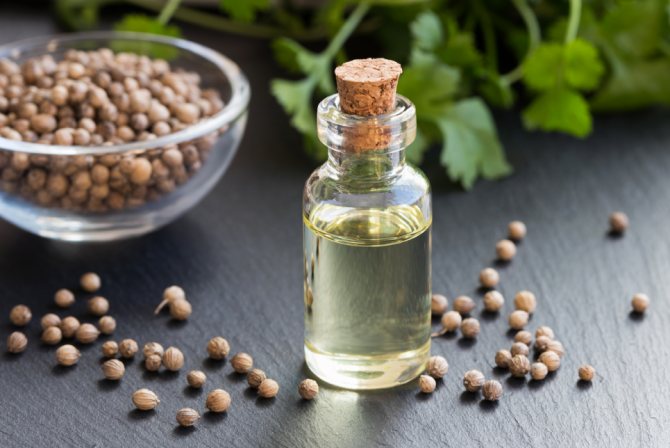

Essential coriander oil
The latter activate the production of enzymes and digestive juices in the body. Therefore, the oil is included in some medicines to restore the function of the gastrointestinal tract and is suitable for treating bloating in animals. However, the severity of its action is weaker than that of caraway or fennel.
One plant and two names: cilantro greens, coriander seeds
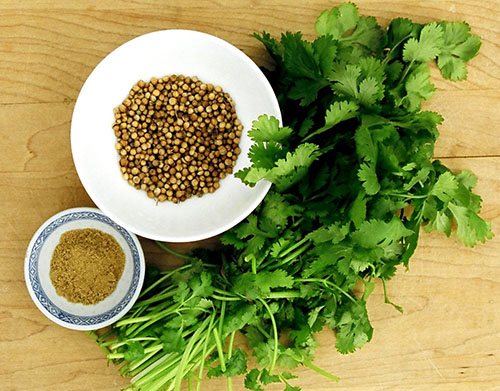

Unsurprisingly, in cooking, coriander foliage, cilantro, and plant seeds are used in very different ways and exhibit dissimilar properties. Moreover, in national cuisines, leaves and grains are not equally popular:
- With a refreshing, pungent aroma and a bitter aftertaste, the greens are good in salads, meat dishes and sauces. Fresh cilantro leaves, as in the photo of the plant, are mainly used in the cuisine of southern peoples, which is probably due to the plant's ability to secrete substances that prevent rotting and the development of harmful bacteria.
- Cilantro seeds called "coriander" have a sweeter, softer and more oily aroma. Therefore, they are used to flavor sausages and vegetable dishes, drinks, soups and baked goods.
How to replace coriander?
Green coriander is replaced with fresh parsley, tarragon and dill, mixing the herbs in equal proportions. Seed or powder is not an alternative to leaves, as it tastes completely different. If the recipe lists these products, you can add cumin or fennel, or both, instead.
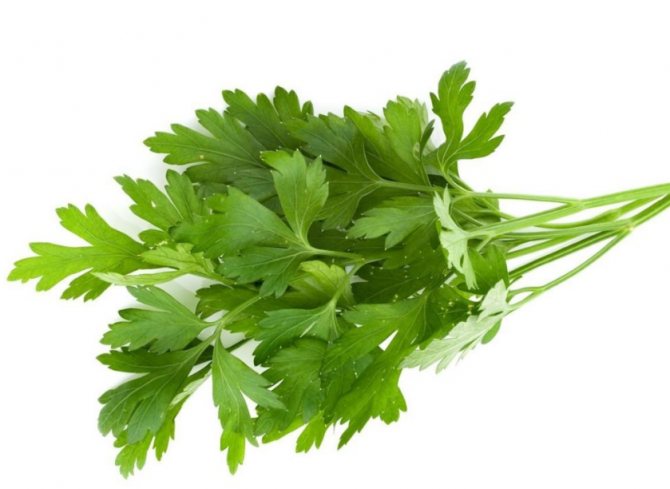

Parsley
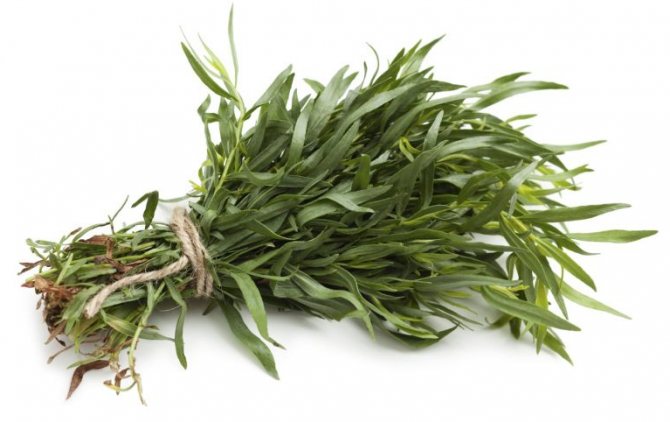

Tarragon
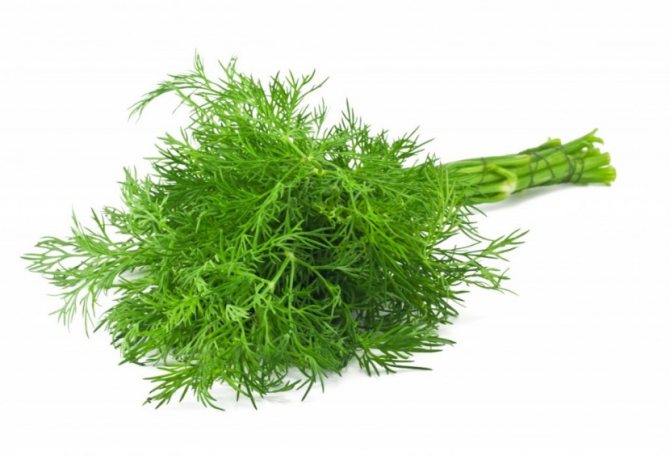

Dill
The use and cultivation of cilantro in the countries of the world
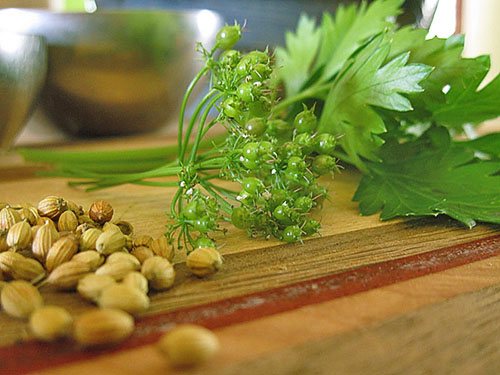

In different countries and corners of the world, the plant is called not only cilantro and coriander, but also kashnich, chilantro and kishnish, chatra, kushtumburu, kolyandra and hamem. Externally, plants from the umbrella family have many similarities. What cilantro looks like is clearly visible in the photo. Because of the similarity to parsley leaves, cilantro greens are called Chinese, Arabic, Chinese and Mexican parsley.
In Indonesian cuisine, coriander is known as ketumbar, while Indians call the spice dhania and grow cilantro to make a mixture of curry and masala spices. In India, coriander is a part of traditional cuisine, and its mention is found in the oldest Sanskrit texts.
Proper care of seedlings
It is not enough to know how to plant coriander, you need to properly care for the plant so that it yields faster. Plant care consists of standard procedures: watering, feeding and weeding.
How to water coriander
Coriander loves loose and moist soil. Moisture deficiency leads to early shooting and a decrease in the quality of greens. In the rain, coriander does not require watering.
At the stage of sprouting, it is enough to water the plant 2 times a week. Water consumption per 1 sq. meter - from 3 to 5 liters. During the period of abundant growth of greenery, watering is increased - by 1 sq. meter takes up to 8 liters of liquid. During flowering, cilantro requires a minimum of moisture - 2 liters per 1 sq. meter.
How to feed coriander
All measures for feeding the soil for coriander are performed before sowing the seeds. In autumn, the soil is mixed with compost, humus and phosphorus-containing fertilizers. Before planting seeds, the soil is fertilized with nitrogen fertilization.
The history of growing cilantro since ancient times
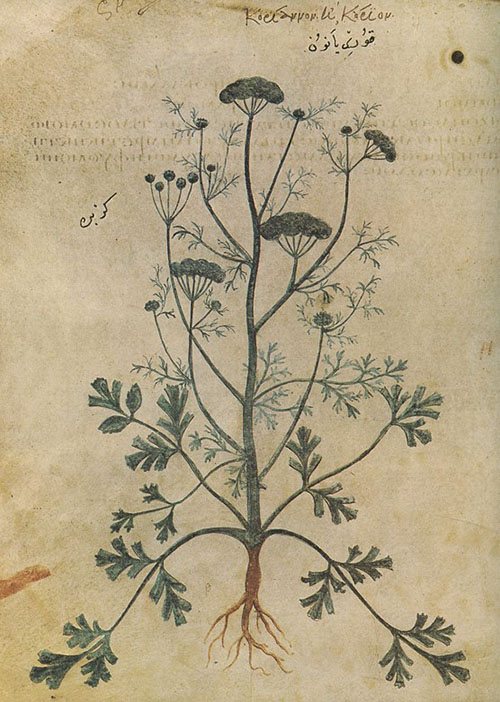

Cilantro is mentioned in the Iberian papyrus, dedicated to the description of natural medicinal plants and poisons and dating back to 1550 BC.Fossilized coriander seeds were found by paleobotanists in the tombs of the XXI dynasty of Egyptian pharaohs. It is believed that the manna described in verse 16:31 of the Bible book of Exodus is the seeds of white coriander.
During the heyday of the Hellenic and Roman civilizations, cilantro seeds called coriander, and perhaps herbs, were widely used as a medicine and spice. Hippocrates writes about the plant in 400 BC, and under the ruins of Pompeii, buried under ash in the 1st century BC, archaeologists also find round coriander seeds. The image of the cilantro plant has been preserved, in the photo, from the book of Dioscorides.
With cohorts of Roman warriors, the plant came to Gaul, and later to Britain. With ground coriander grains and spicy herbs, the invaders flavored unleavened barley porridge and preserved the freshness of the meat.
In the southeast of Great Britain, you can still see wild-growing coriander, which does not let you forget about the distant history of the country.
Fields of application of coriander seed or cilantro
Application in different spheres of human life is found as greens and cilantro seeds, and its essential oil. Here are some ways to use this spice:
- Essential oil of cilantro serves as a raw material for the synthesis of aromatic substances that make up cosmetics and perfumery.
- The fatty oil of coriander, which remains after the distillation of the essential oil, is widely used in the printing, textile and soap industries.
- Coriander is added to a variety of foods: breads, sauces, pastries, cold meats, cheeses, beer, and liqueurs. It enriches the taste of homemade dishes, so it is served with meat dishes in the form of herbs rich in vitamins A and C.
- Cilantro seeds help heal wounds, relieve pain, improve digestion and liver function, eliminate constipation, and heal hemorrhoids, so they are used for medicinal purposes. Cilantro in veterinary medicine is used to remove worms in animals.
- Nutritious coriander meal is used as feed for poultry, rabbits and livestock.
How cilantro was grown in Russia
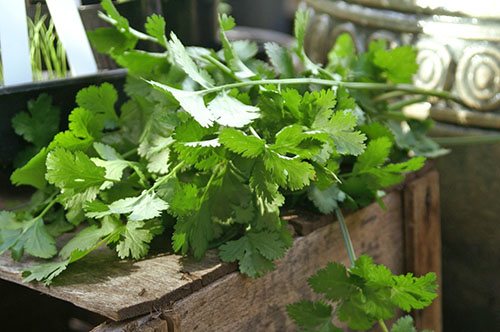

In Crimea, Central Asia and the North Caucasus, the wild coriander is also a memory of how troops and caravans of Sarmatians, Greeks and Persians, Turks and other peoples who have long been engaged in the cultivation of cilantro passed through these lands. Information about the cultivated planting of plants in the gardens of Russia dates back to the second half of the 18th century, and they mention the name "kishnets", which is close to the pronunciation of "geshnes" in Farsi and Turkish "kishnis", speaks of the eastern route of the plant entering Russia.
Mass crops of this culture began only in the 19th century, when Count P.I. Apraksin brought the seed of spicy plants, including coriander, from Spain.
Kinze, who was then called kolyandra, liked it so much on the black soil of the Voronezh province that the plant began to displace the more popular anise.
How to grow cilantro for herbs and seeds?
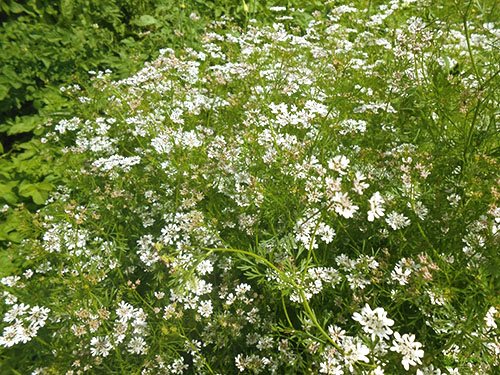

Indeed, cilantro in Russian conditions has shown itself to be an early ripening, unpretentious culture that easily tolerates frost. To grow cilantro for greens and full-fledged seeds, you need a fairly fertile soil and plenty of light, otherwise the stems will be elongated, with rare weak foliage and inflorescences-baskets, consisting of barren flowers. By the way, high temperatures also negatively affect the formation of seeds. If the air warms up above 35 ° C, pollination does not occur, and the number of barren flowers increases sharply.
When to harvest cilantro and coriander seeds?
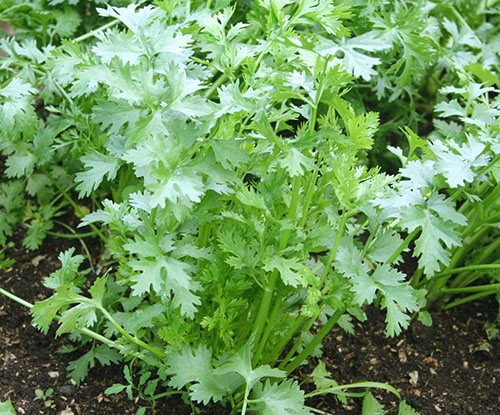

If the goal of the gardener is to get fragrant greenery, then you need to cut the foliage in the rosette phase, before the inflorescences appear. The most valuable are the basal leaves growing on long petioles. When cilantro is harvested, the height of the petioles does not exceed 15 - 20 cm.
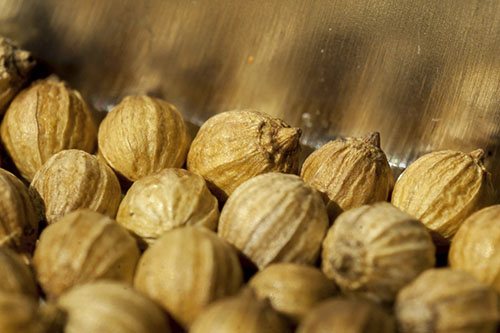

Foliage, growing higher along the stem, gradually loses its three-lobed shape, becomes feathery, elongated and small. After cutting the greens, the coriander is fed.And then, from July to September, the time comes when cilantro is harvested already in the form of seeds.
Re-sowing of cilantro is carried out only with a decline in the summer heat, from August to October.
In many regions of the world, for example, in the Middle East and North Africa, in Asia and the Mediterranean countries, in eastern Europe, India and Russia, coriander is a seed crop, cilantro is grown on an industrial scale, and the lion's share of the crop is not greens, but spicy seeds.
Harvesting and storage of crops
The optimal time for harvesting is about 40 to 50 days after the seedlings appear. During this period, the height of green bushes reaches 15 - 20 cm and attracts attention with its juicy green tint. It is recommended to cut greens in the morning. After collecting, the grass must be thoroughly rinsed and dried from moisture.
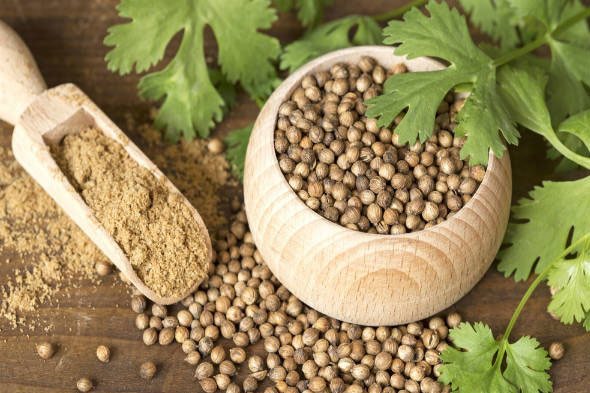

You can store cilantro greens dry and frozen. Before freezing, the green mass is finely chopped, packaged in tight containers or bags and placed in the freezer. For dry storage, the stems and leaves, dried from moisture, must first be tied into small bunches and hung in a dark, dry room with good air ventilation. After the cilantro is completely dry, it is crushed and laid out in tight glass containers or in paper bags.
This healthy spice is suitable for use for more than one year. It can be added to various vegetables and meat, first and second courses.
Tags: spicy herbs
Coriander and its rivals in Asia and the Americas
In the 15th-16th centuries, coriander was brought to the American continent on the ships of the Portuguese and Spanish conquistadors.
Today in the United States, and especially in Latin America, cilantro greens and the seeds of this plant are extremely popular as a seasoning for national cuisine.
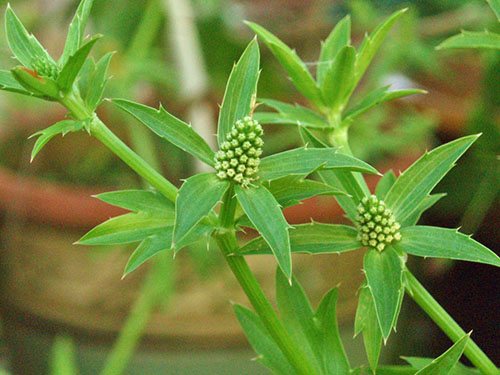

Interestingly, in the American continent, coriander or culantro can be called the plant Eryngium foetidum, which has a similar taste to cilantro and is native to Central America. You can see the rival of cilantro in the photo of the plant. Young leaves of Eryngium foetidum are used as a seasoning in the New World and in a number of Asian countries. Long or Mexican coriander, cultivated by farmers in Costa Rica, has medicinal properties and can be used to neutralize inflammation and relieve pain.
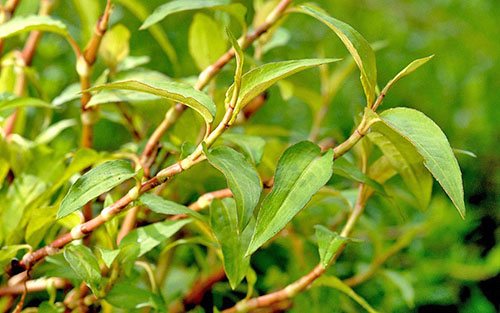

Interesting facts about cilantro include the existence in Vietnam and Malaysia of a plant also called coriander. The local spice belongs to the Buckwheat family. It is Polygonum odoratum or smelly mountaineer. Vietnamese coriander is grown alongside rice and other traditional crops. The highlander is of constant interest to tourists who have not previously encountered an unknown spice. The plant is used in the preparation of national North Vietnamese soups and noodle dishes.
Useful properties of cilantro, coriander - video
Sowing coriander (Coriandrum sativum) is a fast-growing, parsley-like annual 70-80 cm high with strongly dissected openwork leaves and umbrellas of small white flowers. Two spicy plants from tropical countries that have nothing to do with the coriander seed are sometimes called corianders. Vietnamese coriander, or rau-ram, is a fragrant peach (Persicaria odorata) from Southeast Asia, and Mexican coriander, or coulantro, is a fragrant eryngium (Eryngium foetidum) from America.
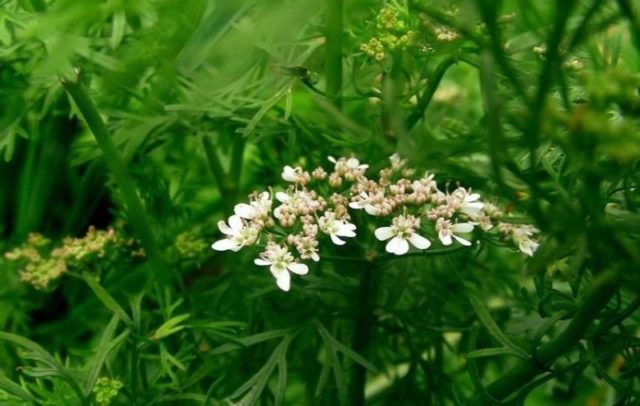

Coriander
For the sake of aromatic foliage, roots and seeds, people have been cultivating coriander for more than three millennia. All of these parts of the plant were found in the tombs of the Egyptian pharaohs. He is also mentioned in the Bible.
- cilantro
Varieties
"Spice"
The variety has gained popularity for its aromatic seeds.
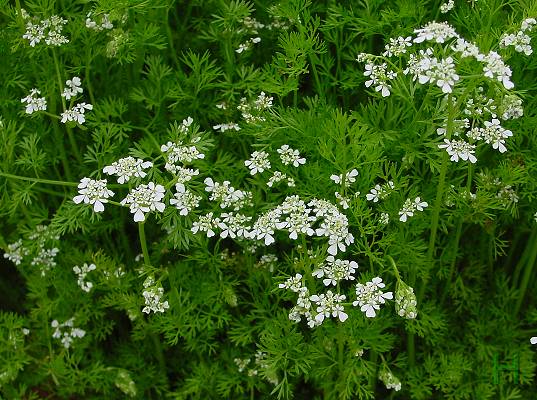

"Spice"
"Santo"
Abundant and tasty dark green foliage.
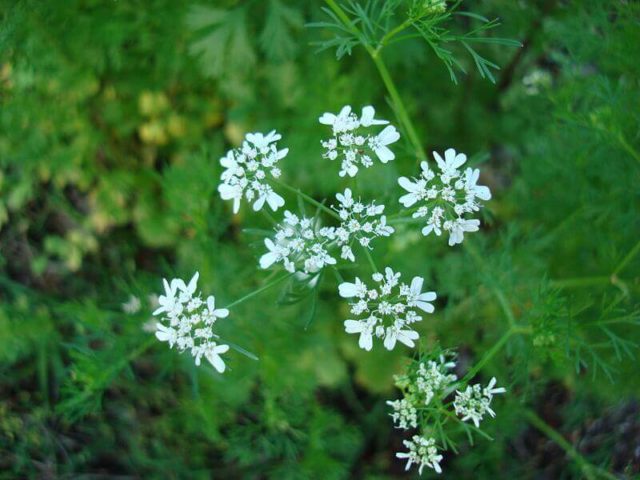

Dark green foliage
Basil
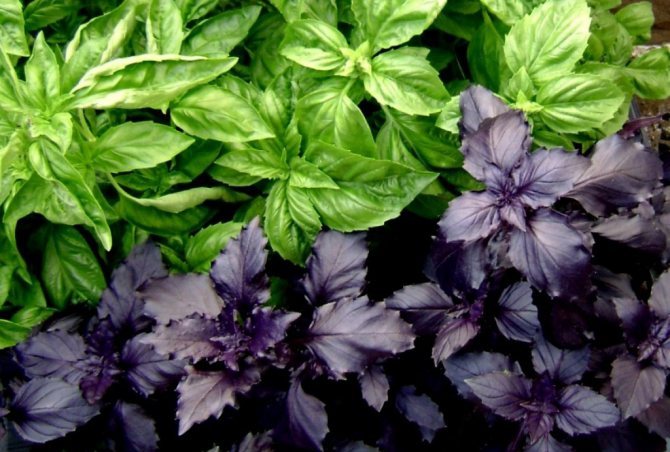

Green and purple basil
Basil is also grown as an annual plant and is eaten with fresh and dried herbs.
Useful properties and application
Basil leaves contain essential oils, tannins, glycosides, phytoncides, vitamins B2, C, PP, provitamin A and other useful compounds.
Basil essential oil has a bactericidal effect, so the plant is widely used to protect against infections and bacteria. For example, it destroys bacteria in the mouth, preventing tooth decay, ulcers, and bad breath.
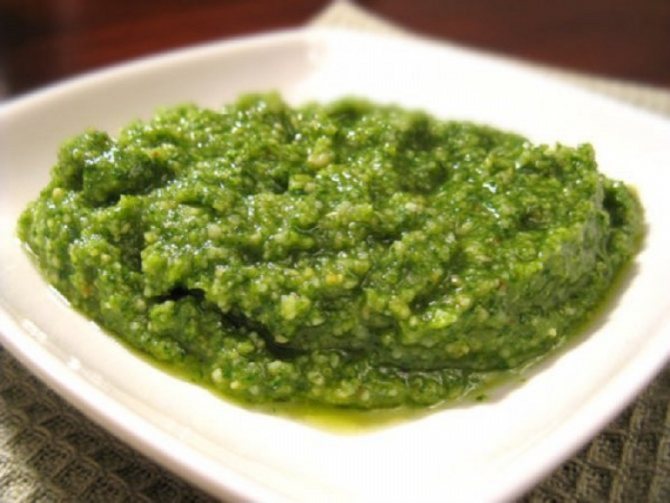

Basil, cheese and olive oil pesto sauce
In addition, it is used to treat cough, gastrointestinal tract, stimulate the immune system, inhibit the growth of carcinogenic cells.
Advice. Basil is eaten not only as a seasoning. Its fresh leaves are brewed and mixed with a little honey for a delicious and very healthy drink.
Growing
Like coriander, basil loves light, fertile soil, generously seasoned with organic matter. It grows well in garden beds after cucumbers, tomatoes, potatoes or legumes. But the place for it needs to be chosen sunny, and at the same time protected from drafts.
It is better to prepare the soil for basil in the fall by digging it onto the bayonet of a shovel and adding, in addition to manure or humus, another 15 g of potassium salt and 25 g of superphosphate per square meter.
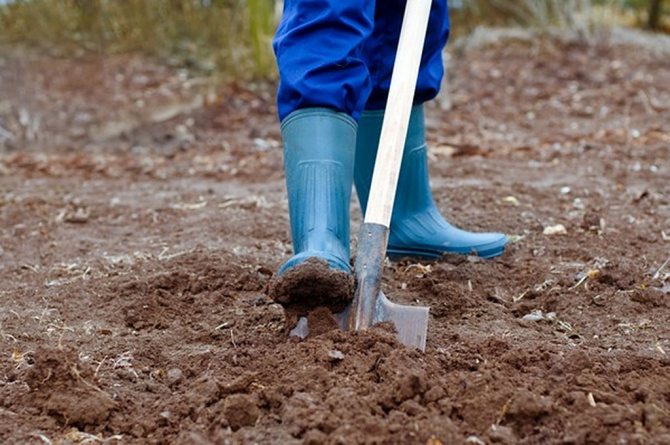

The fertilizer bed must be prepared in the fall.
It is best to grow this plant through seedlings, this way it turns out to get a high-quality harvest faster.
- Seeds are sown in containers with nutrient soil in late March - early April. They are buried in the ground to a depth of 1 cm.
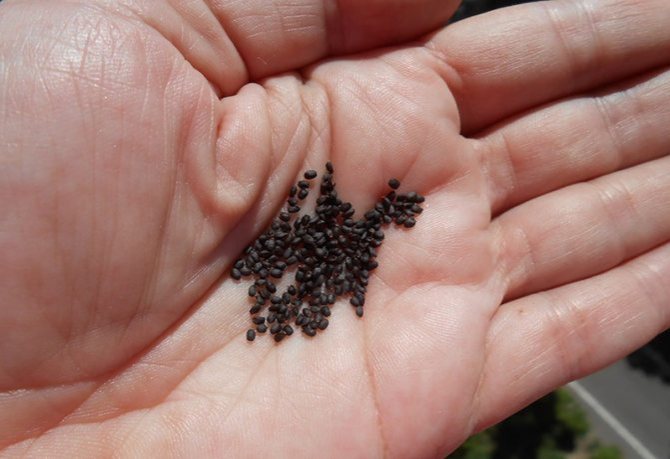

Basil seeds
- Over the next 10 days, they are kept at a temperature of 25-27 degrees and periodically watered, preventing the soil from drying out.
- The grown seedlings are seated in cups and taken out to the greenhouse or on a cool windowsill for hardening.
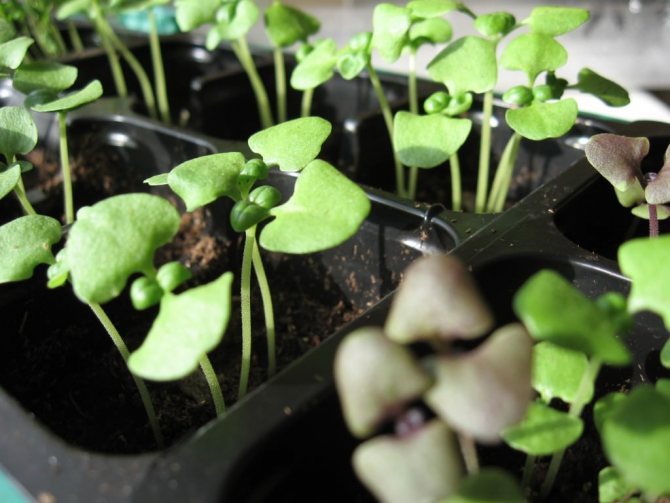

Basil seedlings
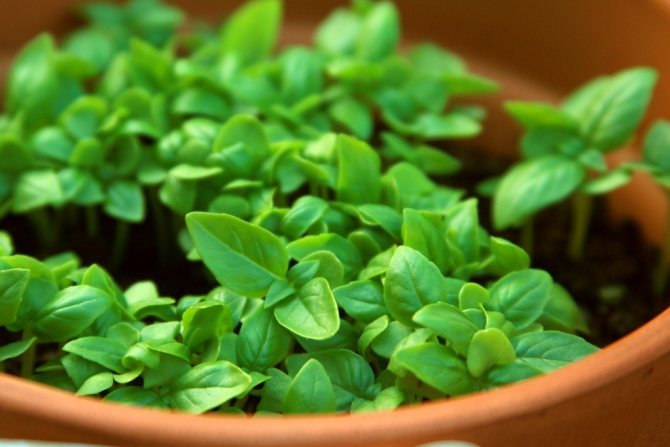

Thickened crops must be thinned out or transplanted
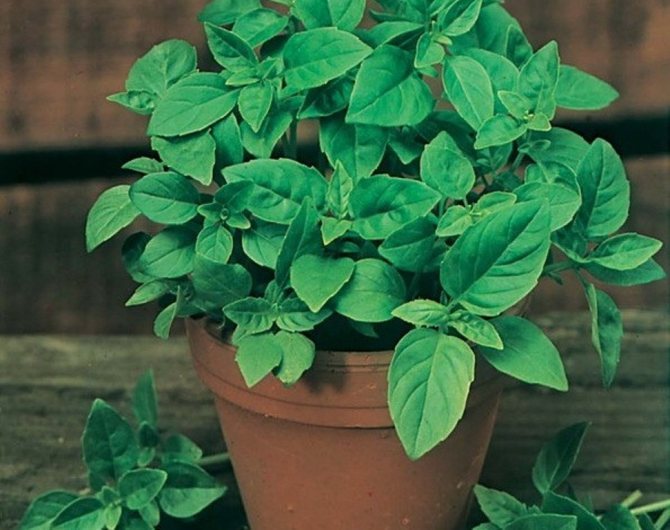

Basil can also be grown in pots at home
- If the seedlings do not grow well, they need to be fed by dissolving 5 g of phosphorus, 2 g of nitrogen and 3 g of potassium fertilizers in one liter of water.
- A week before transplanting into open ground, watering is limited, and the seedlings are hardened, arranging ventilation or taking them out into the air.
Basil is planted in the garden in late May - early June, after the end of the night frosts. The bushes are placed freely, with a distance of 25x30 cm between them. It is very important when transplanting to leave the central bud above the ground.
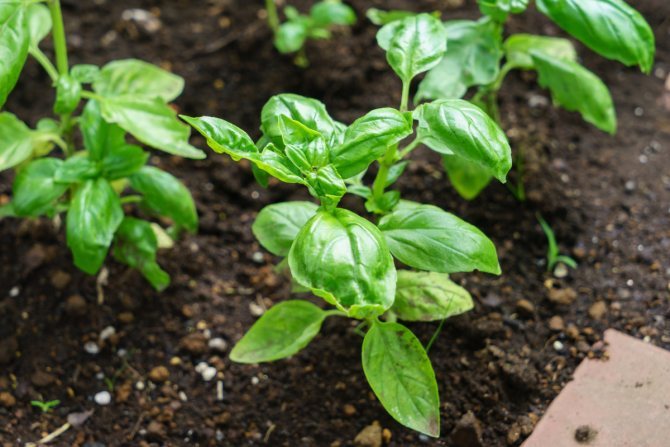

Plants after planting in open ground
Care
Often the plant is watered only while it takes root and assimilates in a new place. Then this is done only when the topsoil dries out.
It is important! Excessive constant soil moisture provokes the disease of basil with gray mold.
As they grow, the upper shoots and flowers are cut off from the bushes. The rest of the care consists in timely weeding and loosening.
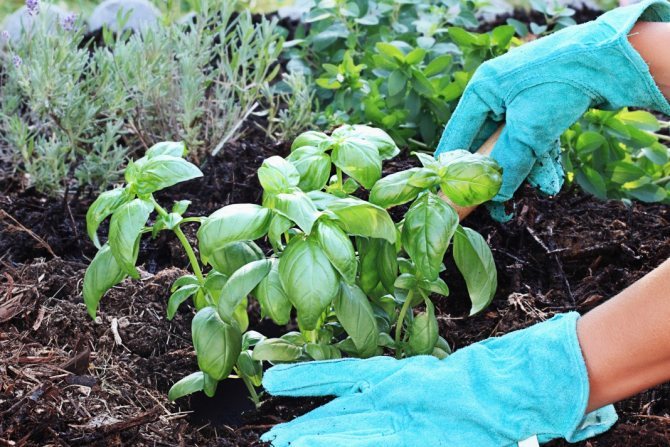

In order not to often loosen the ground, plantings can be mulched
Location
Coriander requires a sunny, well-ventilated area; correct fertilization will reduce the risk of disease.
Reproduction
The seeds are sown in the ground after the last spring frosts.
- Coriander and figs
Even the ancient Romans enjoyed fig pies. Today they are popular in Egypt and Turkey. Take 400 g of soft dried figs and tear off the stems from the fruit. Use a food processor to turn them into a paste and manually shape it into an oval cake. Mix 1 tsp. freshly ground coriander seeds with 1 tsp. flour. Sprinkle this mixture over the cake and serve for dessert.
Weed the seedlings regularly.To prevent premature shooting in leafy varieties, do not let the soil dry out. Feed the plants with liquid seaweed extract for fuller foliage.
Pests and diseases
At the end of the growing season, coriander is sometimes affected by powdery mildew and fungal leaf spot.
Procurement and storage
Collect the seeds when about half of the plants are brown. Tie the cut stems in bunches and hang them with umbrellas down, wrapping them in paper bags, where the seeds will be poured. Leaves can be harvested from mature plants at any time.
Cosmetic and perfume ingredient
In cosmetology, coriander oil is mainly used. However, masks made from leaves are well suited for skin care. Means from the plant stimulate collagen production, make the skin elastic and elastic, and slow down aging.
Because coriander has an intense, warm, spicy aroma, it is used in the perfume industry. Spice enriches the composition with notes.
Mask with honey
Purée 2 tbsp. l. fresh leaves, add with 1-2 tbsp. l. yogurt and 1/8 tsp. honey. Bring the mixture to a creamy state. Apply the mask to face and neck, avoiding the eye area. Leave it on for 15-20 minutes. Then wash it off with warm water.
Cooking
Coriander leaves and stems are a popular culinary condiment in Southeast Asia, the Middle East, South America and Mexico, where they are added to salads, soups, vegetable dishes and curries. In India, coriander leaves are a component of some varieties of chutneys (fruit and vegetable seasonings for meat). Since the leaves lose their aroma from long cooking, they should be seasoned with them immediately before serving.
Frying increases the smell of the fruit. They are added to dishes whole or ground. Their pleasant sweetish taste goes equally well with sweet and spicy dishes, as well as with various spices (such as, for example, harissa). The plant fibers in the ground seeds absorb moisture, thereby thickening curries and stews.
Coriander roots smell even stronger than leaves. They are used in Thai cuisine (for example, in curry spreads).
What to do if the coriander begins to bloom
The beginning of flowering of coriander - a signal that the greens are becoming unfit for human consumption
... You can cut the flower to prolong the growth period of the leaves. If the goal is to get seeds, then you need to let the plant bloom.
The seeds ripen by the end of August. Then they are easily removed from the plant and spread by self-seeding throughout the site. For their preparation, cilantro is cut off entirely and dried under a canopy. The remaining seeds are shaken out of the dried umbrellas.
Store them in cloth bags or glass jars. The shelf life of seeds is no more than 4 years.
Also, coriander can be left to bloom and collected from it in the future.

